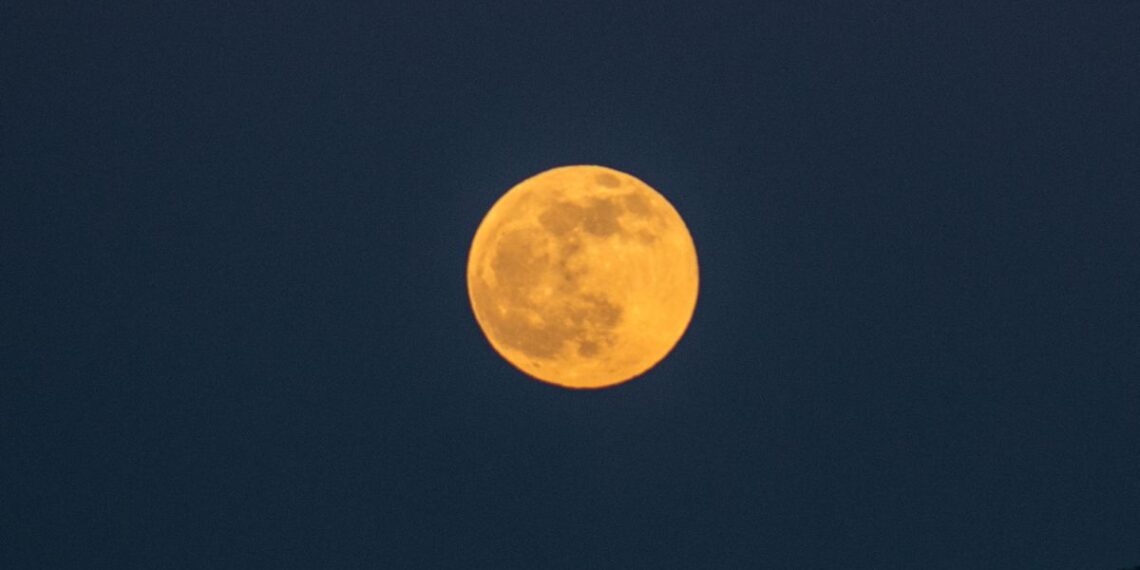A full “Wolf Moon” as seen from Greece on January 10, 2020. (Picture by Wassilios … [+]
Every Monday I select the northern hemisphere’s celestial highlights (mid-northern latitudes) for the week forward, however make sure you check my main feed for extra in-depth articles on stargazing, astronomy, eclipses and extra.
What To Watch For In The Evening Sky This Week: January 25-31, 2021
With a full Moon in its center, this week shouldn’t be significantly good for stargazing, however quite for seeing our Photo voltaic System up shut. On Tuesday, Mercury—the closest planet to the Solar—reaches the very best place above the horizon that it nearly ever does, and within the post-sunset night sky. Take a look at Mars, too, excessive within the southwest after darkish. It’s nonetheless a fantastic sight, however fading quick because it will get farther from Earth. It’s now or by no means!
Within the nights that observe you possibly can watch a waxing Moon turn out to be a full “Wolf Moon,” after which wane thereafter because it rises later every evening. Whereas the Moon’s brightness might get in the way in which of profitable stargazing, it is going to nonetheless be potential to pick-out seven of the brightest stars within the evening sky that collectively comprise the grand “Nice Winter Loop” or “Winter Circle.” Discovered round Orion within the southeast, finding it gives you a strong wide-eyed view of the winter evening sky.
Mercury slightly below Venus within the desert twilight. (Picture by: Alan Dyer /VW PICS/Common Photographs … [+]
Tuesday, January 26, 2021: Mercury at its highest
Though Mercury reached its biggest elongation east a couple of days in the past it’s tonight after darkish that it’s going to seem at its highest above the western horizon. Mercury shouldn’t be usually seen as a result of it orbits so near the Solar, however the “swift planet” is value on the lookout for even simply to say that you simply’ve seen it. It reaches its dichotomy tomorrow, when will probably be 50% illuminated by the Solar (although to the bare eye and binoculars it is going to seem as a single level of sunshine).
Swivel to take a look at the southeastern evening sky anytime after darkish and also you’ll see a a waxing gibbous Moon—now 96% illuminated—about 3.8° from the 2 brightest stars in Gemini; Castor and Pollux.
Full Moon is seen in Ankara, Turkey on December 29, 2020. (Picture by Dogukan Keskinkilic/Anadolu … [+]
Thursday, January 28, 2021: A full ‘Wolf Moon’ within the Beehive Cluster
Also called the “Snow Moon” and the “Ice Moon,” January’s full Moon can be formally 100% illuminated at 19:16 Common Time. The time to catch will probably be at moonrise the place you’re. Will probably be within the constellation of Most cancers, the crab, simply 2.3° from the Beehive Cluster, one of many nearest open clusters of stars, of which there are round 1,000. Though it’s a superb time to find it, M44 will look higher within the coming nights when the Moon has moved out of the way in which (binoculars will even assist). Above the complete Moon you’ll see Castor and Pollux as soon as once more.
Saturday, January 30, 2021: A waning Moon and Regulus
Tonight at moonrise—about three hours after sundown—you’ll see a 93%-lit waning gibbous Moon beneath brilliant star Regulus within the constellation of Leo, the lion. Look to the northeast and also you’ll see the Large Dipper/Plough/Saucepan on its aspect, its deal with pointing downwards.
Canis Minor constellation.
Constellation of the week: Canis Minor
This two-star constellation isn’t a formidable one, but it surely’s necessary to seek out it due to what we’re going to see subsequent. Whereas Canis Main—the massive canine—comprises brilliant Sirius, simply 8.6 light-years distant, the smaller Canis Minor constellation’s important brilliant star is Procyon. Solely 11 light-years away, its identify is Greek for “earlier than the canine” due to its rising earlier than Sirius—the “Canine Star.” It’s accompanied in Canis Main by Gomeisa, a star 180 light-years away from the Photo voltaic System.
The “Winter Loop”
Asterism of the week: the ‘Nice Winter Loop’
It’s time to fulfill the neighbors. Should you’ve been following my stargazing guides lately you’ll probably have realized how you can determine a superb few brilliant stars in and across the constellation of Orion. Now it’s time to place all that collectively and discover arguably probably the most fascinating sight of all for a stargazer this season—the “Nice Winter Loop.” An enormous asterism, or form, its big hexagonal sample joins 5 of the brightest—and closest—15 stars in the complete evening sky.
Begin at Sirius, low on the horizon, and journey south to Rigel beneath Orion’s Belt. Now go as much as orangey Aldebaran (to not be confused with the purple planet Mars barely additional to the south), up once more to brilliant white Capella, then flip again east to the 2 stars of Gemini—Castor and Pollux. Dive in direction of the horizon in your method again to Sirius, and also you’ll discover Procyon.
You’ve discovered one of many nice circles in nature! Discover, and re-find, the “Nice Winter Loop” and also you’ll have your self a superb wide-eyed view of the winter evening sky. It’s invisible in summer season; the Solar sits in its heart each June.
Instances and dates given apply to mid-northern latitudes. For probably the most correct location-specific info seek the advice of on-line planetariums like Stellarium and The Sky Live. Test planet-rise/planet-set, sunrise/sunset and moonrise/moonset instances for the place you’re.
Wishing you clear skies and broad eyes.
Supply: www.forbes.com


